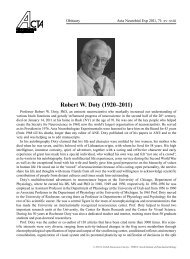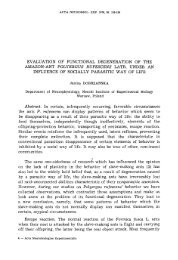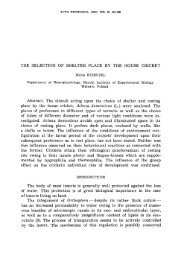Auditory perception of temporal order in centenarians in comparison ...
Auditory perception of temporal order in centenarians in comparison ...
Auditory perception of temporal order in centenarians in comparison ...
You also want an ePaper? Increase the reach of your titles
YUMPU automatically turns print PDFs into web optimized ePapers that Google loves.
376 I. Kolodziejczyk and E. Szelag<br />
Procedure<br />
Subjects <strong>in</strong> the two younger groups were tested <strong>in</strong>dividually<br />
<strong>in</strong> a soundpro<strong>of</strong> room at the Nencki Institute.<br />
The very old people were tested at their homes, as the<br />
transportation to the Institute would be difficult and<br />
stressful for such old people. The very simple experimental<br />
paradigm created a relatively easy task for the<br />
very old participants.<br />
The stimuli were ‘square’ tones <strong>of</strong> 300 Hz generated<br />
by a 16-bit SoundBlaster Card and presented for 15 ms<br />
monaurally via headphones at a comfortable listen<strong>in</strong>g<br />
level. The tones were presented <strong>in</strong> pairs; each pair consisted<br />
<strong>of</strong> one tone presented to the left (L) and the other<br />
to the right (R) ear. Between the tones <strong>in</strong> each pair<br />
there was an ISI (i.e. time between the <strong>of</strong>fset <strong>of</strong> the<br />
first tone and the onset <strong>of</strong> the second one) <strong>of</strong> either 10,<br />
20, 40, 60, 80, 100, 150, 300, 500 or 1 000 ms. The<br />
subject’s task was to report the <strong>temporal</strong> <strong>order</strong> <strong>of</strong><br />
stimuli <strong>in</strong> the tone pairs (R-L vs. L-R). If the tones<br />
were perceived by the subject as simultaneous, she/he<br />
could answer ‘I do not know’ (D-n-K), however, this<br />
answer was counted as an error. Dur<strong>in</strong>g the experiment,<br />
12 presentations <strong>of</strong> each ISI were randomly<br />
<strong>order</strong>ed. Thus the experimental session consisted <strong>of</strong><br />
120 trials. The <strong>order</strong> <strong>of</strong> tones <strong>in</strong> half <strong>of</strong> the trials was<br />
R-L, whereas <strong>in</strong> the other half it was L-R. The time<br />
between the subject’s response and the presentation <strong>of</strong><br />
the first tone <strong>in</strong> the next trial was 2 s.<br />
The proper experiment was preceded by a practice<br />
session to familiarize the participants with the task. At<br />
the beg<strong>in</strong>n<strong>in</strong>g <strong>of</strong> the practice session, s<strong>in</strong>gle tones were<br />
presented and the subjects were requested to <strong>in</strong>dicate<br />
the stimulated ear. Next, they were requested to report<br />
the <strong>order</strong> <strong>of</strong> two tones presented <strong>in</strong> pairs with a constant<br />
ISI <strong>of</strong> 500 ms. If dur<strong>in</strong>g the presentation <strong>of</strong> 24<br />
consecutive trials the <strong>order</strong> <strong>of</strong> at least 20 pairs was<br />
reported correctly, the proper experiment began. In the<br />
two younger groups the experiment took approx.<br />
30 m<strong>in</strong>utes. For the <strong>centenarians</strong> it lasted about<br />
1 hour.<br />
Data elaboration and statistical analyses<br />
The analyzed variable was the <strong>temporal</strong>-<strong>order</strong><br />
threshold (TOT), def<strong>in</strong>ed as the ISI at which the probability<br />
<strong>of</strong> correct response was 75%. To calculate the<br />
TOT for each subject, the psychometric functions<br />
were fitted to his/her experimental data us<strong>in</strong>g the<br />
psignifit toolbox version 2.5.41 for Matlab (see http://<br />
bootstrap-s<strong>of</strong>tware.org/psignifit) which implements<br />
the maximum-likelihood method described by<br />
Wichmann and Hill (2001). Then, the ISI was assessed<br />
for which the psychometric function reached 75% <strong>of</strong><br />
correct responses. TOTs obta<strong>in</strong>ed by <strong>in</strong>dividual subjects<br />
were then submitted to Analysis <strong>of</strong> Variance<br />
(ANOVA). A post-hoc analysis was performed us<strong>in</strong>g<br />
the Tukey test. Moreover, the frequency <strong>of</strong> D-n-K<br />
responses was analyzed with Kruskal-Wallis and<br />
Mann-Whitney tests.<br />
RESULTS<br />
A two-way ANOVA with between-subject factors<br />
‘age’ (young, elderly and very old adults) and ‘gender’<br />
(men vs. women) showed a significant effect <strong>of</strong> ‘age’<br />
(F 2,40=44.2, P









